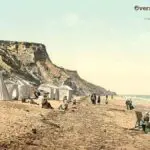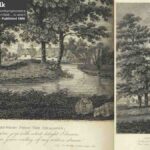Glimpse history through old images of Gorleston-on-Sea, Norfolk, England, usually known as Gorleston.
Part of Suffolk until 1832, when it became a part of Great Yarmouth for electoral purposes, Gorleston was merged into Great Yarmouth in the county of Norfolk in 1835.

Motor Life Boat (1926)
The new motor life boat, launched in 1926, would allow the sea recuers to reach their target more quickly now they didn’t need to row for long periods thrugh rough seas.
It was the same year the R.N.L.I. station was renamed from Gorleston station to Great Yarmouth and Gorleston station.
For Those In Peril On The Sea & Cuts (1926) – British Pathé on YouTube
A bit of Gorleston history
Extract from: History, Gazetteer and Directory of Suffolk, Comprising a General Survey of the County, and Separate Historical, Statistical and Topographical Descriptions of All the Hundreds, Boroughs, Towns, Ports, Parishes, Townships, Chapelries, Villages, Hamlets, Manors and Unions … the Seats of the Nobility and Gentry; Magistrates and Public Officers; and a Great Variety of Other Archaeological, Architectural, Agricultural, Biographical, Botanical, Geological and Statistical Information, by William White
Published in 1874
Pages 433 – 434
GORLESTON is a large and handsome village, pleasantly situated on the crown of a hill, about two miles S. of Great Yarmouth, overlooking the river Yare, which flows in a rapid stream at the foot of the acclivity, and about a mile below is lost in the wide expanse of the German Ocean, after being separated from it for about three miles only by the narrow strip of land upon which Great Yarmouth is built.
The Parish of Gorleston is in Mutford Union and Yarmouth County Court district, and comprises also the populous hamlet of South Town, or Little Yarmouth, which was anciently a separate parish, and was added to the Borough of Great Yarmouth in 1681, as also was Gorleston by the Parliamentary and Municipal Reform Acts of 1832 and 1835.
It has a rateable value of £ 21,357, and comprises 2135A. 18. 23r. of land, and its population increased from 1728 inhabitants in 1801 to 6653 in 1871.
Of these contents 691A. 18. 3P. and 2251 persons are in South Town hamlet, and 1441A. 20r. and 4402 persons in Gorleston. The rateable value of the latter is £10,125.
According to Domesday Book, the whole parish was in one manor, held by Earl Guert in the Confessor’s time, and having 20 villeins, 24 fishermen, five carncates of land, five bordars, two carucates of demesne, three salt pans, and 300 sheep.
Afterwards, the parish was in four manors, a paramount, a principal, and two mesne, of all of which the Jernegans were lords.
It is now only in two, viz., the paramount manor of Gorleston, of which Richard Henry Reeve, Esq., is lord; and the small manor of Bacon’s, which is held in fee by the Trustees of the late Samuel Palmer, Esq., but the soil and buildings belong to various owners, the largest of whom are the Earl of Lichfield ( owner of most of the land in South Town ), Mrs. Garnham, Messrs. Salmon Palmer, Thomas W. Gooda, Frederick Dendy, E. H. H. Combe, Hezekiah Martin, and several smaller owners.
The greater part of South Town is let on building leases for the term of 99 years.
The waste lands in the parish were enclosed under an act passed in 1812.
Tradition says that Gorleston had once a weekly market; and the “Index Monastiens” informs us that in 1372 it had a house of lepers, but the site is unknown.
By custom, it has a small fair at Whitsuntide for toys and pleasure.
In 1797, the mutilated remains of a stone cross were visible, a little south of the village, but they disappeared many years ago.
Almost every part of Gorleston commands a sea prospect over the Yare and the town of Yarmouth, where the Norfolk Naval Column, erected in 1817, in memory of Lord Nelson, is a conspicuous and pleasing object.
The village has many excellent houses for the accommodation of sea bathers.
The South Pier, which projects into the sea, at the mouth of the Yare, was greatly enlarged some years ago, and a continuation of it carried up the river forms an extensive and excellent wharf.
It is constructed chiefly of large timber trees, joined and braced together by eroes beams of iron work, and measures 340 yards in length, 30 feet in breadth, and 30 feet in depth, of which latter 26 feet are generally under water.
This pier, and about 30 acres, formerly marsh lands, called Cobholm Island, which have within the last seven years been drained and sold for building purposes, belong to Yarmouth parish, through on the Gorleston side of the river.
The white cliffs, extending in an uninterrupted curve from Gorleston to Lowestoft, are of some elevation, and afford delightful views of the harbour, the town, the ocean, and the adjacent country.
THE CHURCH (St. Andrew), which stands on a commanding eminence a little south-west of the village, is a large, and for the most part, an ancient structure, chielly of flint, and consists of nave, with aisles, chancel, south porch, and a square embattled tower 90 feet in height, containing a peal of six bells, presented in 1872 by Miss M. Chevallier Roberts.
The fabric had been so long in a very dilapidated condition that the parishioners and other friends determined, in 1871, to make an appeal for funds to repair it. They were so successful in their efforts that soon afterwards the north wall, of singularly beautiful external flint work, which had been dangerously out of perpendicular, was taken down and rebuilt.
The south porch, owing to the necessity of lowering the soil for a distance of twelve feet around the entire building was treated similarly.
Some of the windows which had been bricked up have been re-opened, the stone work of the others has been renovated, and all the windows have been glazed with cathedral glass.
A new chancel arch has been erected, the tower arch re-opened, the old gallery and vestry removed, and the old thatched roof superseded by an entirely new open timbered boarded roof, covered with Staffordshire tiles.
The reredos is the gift of Mrs. Cory, and the choir stalls and chancel screens were presented by the Roberts family.
The entire restoration cost about £ 1,680.
In cleansing and repairing the interior about the year 1839, a piscina, Sepulchrum Christi, and other antiquities, were discovered, and also two beautiful fresco paintings, one of which was demolished, and the other, though much injured, was visible until the late restoration, when it and other very interesting frescos, uncovered by the removal of plaster, & c., were renewed.
There is a fine brass in memory of a Crusader.
The curious antique font, which had long been covered with plaster and whitewash, was cleansed in 1812, when its rich painting and gilding were found untarnished, but much of its beautiful sculpture was destroyed by the Puritans. It is octagonal, and its sides have carvings representing the Seven Sacraments, and the Day of Judgment.
The benefice is a vicarage, with the rectories of the decayed parishes of South Town and West Town annexed to it, and valued in K.B. at £ 11, and now at £ 31 per annum, and is in the patronage of Henry Allmutt, Esq., and in the incumbency of the Rev. Francis Upjohn, M.A., who is non resident, and for whom the Rev. Thomas Allnutt, B.D., officiates.
THE INDEPENDENTS have two chapels, one erected in 1826, at a cost of about £550, and the other in 1860, at an outlay of £800.
THE FREE METHODISTS, PRIMITIVE METHODISTS, and WESLEYANS, have also places of worship.
THE BAPTISTS hold services in the Oddfellows Hall.
THE NATIONAL SCHOOL was built in 1840, at a cost of about £1,100, raised by subscription. It is supported by Government grant, subscription, and the children’s pence. There is an average attendance of 360.
Gas Works were erected in 1854, at a cost of £ 4,320, in shares of £ 10, and enlarged in 1872, at an expense of upwards of £ 2,000. Gas is supplied at the rate of 6s.6d. per 1000 cubic feet.
The Oddfellows ‘ Hall was erected in 1866, at an outlay of £ 600, and is let for public meetings, & c.
There is a service reservoir belonging to the Yarmouth Water Works Company, constructed in 1872-3.
A life boat, under the National Life Boat Institution, is stationed here.
POST and MONEY ORDER OFFICE and SAVINGS BANK at Mr. John Hammond’s, High street. Letters are delivered at 7 a.m., and are despatched at 2.20 and 6.20 p.m. to Yarmouth.
More about Norfolk
- Old Images of Norfolk, England
- Old Images of Wymondham, Norfolk
- Old Images of Thetford, Norfolk
- Old Images of Sheringham, Norfolk
- Old Images of King’s Lynn, Norfolk
- Old Images of Hunstanton, Norfolk
- Old Images of Hingham, Norfolk
- Old Images of Gorleston-on-Sea, Norfolk
- Old Images of Fakenham, Norfolk
- Old Images of Diss, Norfolk
- Old Images of Dereham, Norfolk
- Old Images of Overstrand, Norfolk
- Old Images of Attleborough, Norfolk
- Old Images of Holt in Norfolk
- Old Images of Cromer, Norfolk















